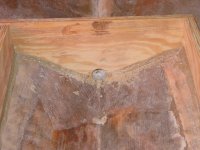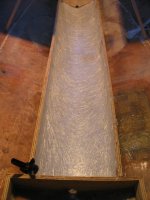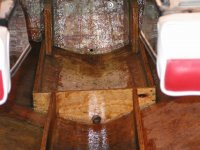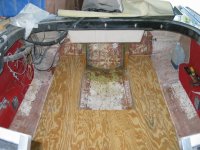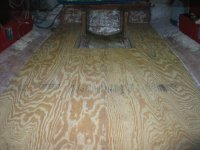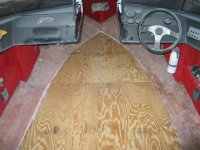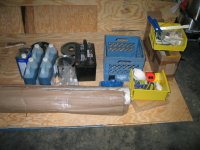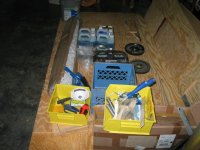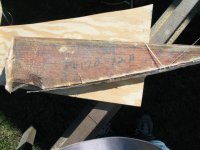-
Welcome to the Checkmate Community Forums forums.
» Interact with over 10,000 Checkmate Fanatics from around the world!
You are currently viewing our boards as a guest which gives you limited access to view most discussions, articles and access to our other FREE features.
By joining our free community you will be able to:
» Post topics and messages
» Post and view photos
» Communicate privately with other members
» Access our extensive gallery of old Checkmate brochures located in our Media Gallery
» Browse the various pictures in our Checkmate photo gallery
Registration is fast, simple and absolutely free so please, join our community today!
If you have any problems with the registration process or your account login, please contact support by clicking here or by using the"contact us" link at the bottom of the page.
You are using an out of date browser. It may not display this or other websites correctly.
You should upgrade or use an alternative browser.
You should upgrade or use an alternative browser.
Pulse170 Floor Restoration
- Thread starter Rob B
- Start date
- Status
- Not open for further replies.
I'm thinking of the condensation that'll be trapped inside of the 'water-tight' box you're building. I think you're still supposed to have drain holes front to back regardless..............
I didn't think about that, good observation.
Mark
Well-known member
On the other hand that is why they rot in the first place. The water freely flows from the bilge and gets in there where it never dries out. That is why they had those slatted ski locker doors so the area can dry out.I'm thinking of the condensation that'll be trapped inside of the 'water-tight' box you're building. I think you're still supposed to have drain holes front to back regardless..............
It's not just the water passing front to back you gotta worry about though. All that new wood getting installed is quite 'wet'. Even though all the new wood is getting covered in glass and resin, over time the moisture in the wood and the condensation inside a closed box is going to rot all that wood anyway....................
Mark
Well-known member
How does the moisture pass from the wood into the box or vice versa, through the fiberglass and resin encasing the wood?Even though all the new wood is getting covered in glass and resin, over time the moisture in the wood and the condensation inside a closed box is going to rot all that wood anyway....................
Over time, water will pass through everything. Very reason why hulls left in the water all summer will come out with osmotic blilstering. My '95 Persuader had blistering when I bought it. Lots of little pock-marks. Didn't get any worse, as I never let the boat sit in the water over-night.
No matter how long wood is dried, it still contains some moisture. When it's encased in fiberglass, the water is mostly trapped inside. The closed-in box will have ambient air in it before it's closed in, which contains moisture.
The only way to keep moisture from 'sitting' and working it's way through the fiberglass is to provide air holes so that the moisture can get out as it forms into water and drops to the bottom of the cavity. With the passageways in place, every time the boat is stored (properly, with the bow high) the water can then drain out the back through the drain hole. The drain hole isn't quite at the bottom of the boat, so after mine drains a while I stick some rolled up paper towel in and let it soak up what's left.
Right now my Pulse is stored for the winter. I have a 5' long 2X4 under the tongue holding the trailer up way nose-high. I have my shore station adjusted so that the bow is always high during the week while the boat sits unused. Once a week I float around the back of the boat and pull the drain plug. After a huge rain we had this summer, I found I had to clear out one of my drain passageways to allow the water to flow to the back better. Like usual, my ski locker carpet was blocking the drain hole.
No matter how long wood is dried, it still contains some moisture. When it's encased in fiberglass, the water is mostly trapped inside. The closed-in box will have ambient air in it before it's closed in, which contains moisture.
The only way to keep moisture from 'sitting' and working it's way through the fiberglass is to provide air holes so that the moisture can get out as it forms into water and drops to the bottom of the cavity. With the passageways in place, every time the boat is stored (properly, with the bow high) the water can then drain out the back through the drain hole. The drain hole isn't quite at the bottom of the boat, so after mine drains a while I stick some rolled up paper towel in and let it soak up what's left.
Right now my Pulse is stored for the winter. I have a 5' long 2X4 under the tongue holding the trailer up way nose-high. I have my shore station adjusted so that the bow is always high during the week while the boat sits unused. Once a week I float around the back of the boat and pull the drain plug. After a huge rain we had this summer, I found I had to clear out one of my drain passageways to allow the water to flow to the back better. Like usual, my ski locker carpet was blocking the drain hole.
After thinking about it, I'm going to cut a drain hole in each bulkhead and on each stringer to let air in and water to escape. I'm not replacing the foam in the floor, so any water/condensation will be able to drain back to the bilge area. I've actually built up the area next to the drain hole since Checkmate has it about 1 1/2" off the bottom. Then I'll glass everything in place. By doing that if I decide to put the ski locker back in the drain holes will be there. Jw has a point, I had the same problem with the carpet in the ski locker plus the drain hole wasn't big enough.
Mark
Well-known member
It can't hurt to have drain holes. However, only the ski locker has a drain from the factory. Like JW says the are notorious for trapping water in the carpet.
The 2 side compartments are filled with foam and have no drains. The water gets into the foam from the screw and staple holes above where it get trapped in the foam and rots the stringers and floor from the inside out.
Moisture does not travel through several layers of fiberglass. If it did, the core would be rotted on every boat that ever spend a summer in the lake. Blistered hulls are common and are caused by the water travelling through porous gelcoat and a getting trapped between the layers.
Send Coop a PM he knows more about this stuff than all of us put together.
The 2 side compartments are filled with foam and have no drains. The water gets into the foam from the screw and staple holes above where it get trapped in the foam and rots the stringers and floor from the inside out.
Moisture does not travel through several layers of fiberglass. If it did, the core would be rotted on every boat that ever spend a summer in the lake. Blistered hulls are common and are caused by the water travelling through porous gelcoat and a getting trapped between the layers.
Send Coop a PM he knows more about this stuff than all of us put together.
I disagree about 'water won't travel through several layers of fiberglass' after all the pix of rotted cores I've seen, in areas where there has been no breach (like the screw holes Robbie had). Just look at the dozens of Hydrostream rebuilds where there was bad cores and decent fiberglass over the cores. All it takes is time. Even boats like ours that not only have several layers of fiberglass, but good epoxy paint over all THAT we can still get rotted cores. Probably all depends on how good a job the 'glass layers did when laying up a new hull.
I think that's why Allison has such great resale value, no wood to rot over time..................
I think that's why Allison has such great resale value, no wood to rot over time..................
Mark
Well-known member
I hear you and I'm not trying to pick an arguement. But it is a worthwhile discussion. Hydrostream cores all rotted because they did not have properly glassed in cores. To save weight they had one layer of roving and often sealed so poorly that the water seaped right in through the tiny holes. Properly glassed in balsacore will not rot. My Starliner had a floor and stringers that had turned to compost. The foam was so waterlogged I could barely lift it. Yet, other than where screws had perforated the coring the balsacore is dry and perfect.
Old Hickory
Active member
I disagree about 'water won't travel through several layers of fiberglass' after all the pix of rotted cores I've seen, in areas where there has been no breach (like the screw holes Robbie had). Just look at the dozens of Hydrostream rebuilds where there was bad cores and decent fiberglass over the cores. All it takes is time. Even boats like ours that not only have several layers of fiberglass, but good epoxy paint over all THAT we can still get rotted cores. Probably all depends on how good a job the 'glass layers did when laying up a new hull.
I think that's why Allison has such great resale value, no wood to rot over time..................
JW,
I agree mostly with your assessment regarding rot; and I agree that water will eventually seep and damage most anything(the delamination...blistering.... you refer to when boats have been in the water excessivly) However, there is more to it than just moisture; infact, some moisture is good and necessary. Here is a post I had prepared last night for this thread. I opted not to post it; but instead, decided to expand on it and put it in my blog. Here is a snip it of what I will be doing for my next post. I'll be discussing materials and the causes of rot in most applications.
Robbie,
I'm going to throw my 2 cents in here and also shed some light on the state of rot
Let me first start by saying I don't engineer plywood and I am not an expert in wood boat building(you know that, but hey, I guess I need to qualify for those who don't know me). However that being said; before I began my Enforcer resto I was only a few months away from starting a large wooden boat project( Tolman Jumbo skiff). I still plan on building this boat; but I won't try to tackle it for several more years. During my research, I accumulated a small library of boat building manuals. Here is what I have learned about building boats with ply regarding moisture.
Wood has to have a certain percentage by weight of water. Marine A; AB douglas fir should have 8-10% with 15% being the upper acceptable range. Hardwoods should have a little higher content 15% being the acceptable starting point. If you don't have the proper amount of moisture, the wood is weakened; either too brittle or will become susceptible to memory and warping.
Moisture at these levels are a good thing. They maintain the the strength to weight ratio's that make wood superior to most boat building products in both cost and workability. Most reputable boat builders that build with wood, will mantain that you should have no rot or failure issues with ply or wood that have these levels of moisture; as long as they are "properly installed and encapsulated".(note: I'll also add "mantained" here as well)
Key phrase; "properly installed and encapsulated". Epoxy is by far the superior coating for encapsulating wood on the market. It bonds more firmly than polyester and is generally more flexible without releasing. Because of these qualities, it is better suited to prevent excessive moisture and air(the deadly combination) to enter the encapsulation of the wood, due to the plastics failure; thus preventing rot.
The newer polyesters we use for boat repair have much better adhesion to wood than those in the past and tend to be less brittle. They are better able to encapsulate the ply without failure and release; but still not as good as epoxy.
Our checkmates rot problems are not due to the use of wood. They are instead due to failure of the adhesion between the wood and the polyester resin, thus allowing water to penetrate a much larger surface area of the wood; and also allowing air to be trapped between the glass and wood surfaces. This causes the rot! As long as the encapsulation remains intact and air tight with the appropriate moisture content; the wood will maintain it's integrity and be preserved. Have you noticed that when you remove a rotted portion of your boat; there is always seperation of the wood from the glass? The rot didn't necessarily cause the seperation. The separation was more likely caused by loss of adhesion; the encapsulation was breached; water and air were introduced and rot ensued. Decay eventually completed the seperation.
Another example of the relationship between water, air and rot is the recovery of vintage logs off the bottom of our rivers and shipping lanes. Those logs have been submerged under water and mud between 75 to 150 years... saturated and encapsulated. Why are they not completly decayed? The answer is the lack of air. Wood pylons for docks don't decay nearly at the rate as they do at the water line.....the answer? introduction of air. basic principles of bilology, oxidation and decay.
I know this is long.....the point is, if you are getting good adhesion to your wood and encapsulating thoroughly; the ply you are using should last you a lifetime or longer. Take care when breaching repairs ie: drains; fasteners etc. be sure they are carefully and properly resealed. When I look carefully at all the rot on my Enforcer; release of the polyester from the wood and breaches to the encapsulation were the biggest culprit in the rot of my boat. Couple that with excessive saturation and entrapment of air make for the inevitable.
So based upon the above; fully encapsulating your boxes w/o drains should not be a big issue as long as the "tub" you create dosn't have installation flaws or any impromptu breaches down the road. But, you don't want a potential "tub" in the middle of your boat. I agree w/ JW in that you need some drains installed(you might check out Jupiter Pulsares thread on his stringer and floor replacement; the drains he installed were very impressive) be sure to adequately glass any drain holes so as to prevent a potential breach.
Second, If you are using a good quality Marine/Exterior grade A or AB plywood; and have kept it in a dry area; your moistuer content should be exceptable.
Sorry again for the long post. I hope this helps and I hope I havn't offended anyone.
Hick
FYI I didn't choose the coosa because of it's low rot resistance(I'm not completely sold on that); I chose it because of it's weight and better adhesion to polyester.
If anyone wants to know my reference material they should check out:
"Boatbuilding with Plywood" By Glen L Witt. 3rd edition.
"The Dory Book" By John Gardner.
" The Epoxy Book" West System Three Publication
"From a Bare Hull" By Ferenc Mat'e
A.P.A The American Plywood Mfg Assoc.
if these don't convince you; pull out a highschool biology and organic chemistry book.....basic organism /enzyme decomposition and chemical oxidation.
Again, I am no expert on boat repair; but I do have a level of experience in working with and keeping wood preseved. Wood is wood; rot is rot... the principle relationship between the two are the same whether on land or water.
Hick
yellowfiero88
Well-known member
As I was reading through your post the first thing I thought about was the river logs and how preserved they are.Another example of the relationship between water, air and rot is the recovery of vintage logs off the bottom of our rivers and shipping lanes. Those logs have been submerged under water and mud between 75 to 150 years... saturated and encapsulated. Why are they not completly decayed? The answer is the lack of air. Wood pylons for docks don't decay nearly at the rate as they do at the water line.....the answer? introduction of air. basic principles of bilology, oxidation and decay.
Hick
A+ info hick

Today I've got a bunch done,I've added drain holes to the bulkheads for a piece of mind and at the suggestion of my fellow C'mater's. Word of note since we're talking about plywood, I did buy the top grade exterior board. Moving right along, I've got the stringers glassed in place, I'll have to glass the bulkheads sometime this week. Second I've got the floor cut out and laying on the garage floor. I've got some pictures of my supplies as well as the progress that was made today. So here is the update.
Attachments
Old Hickory
Active member
Good Job

What about drain holes thru the stringers and transom knees where they join the transom? The center of your boat looks to be well drained; but can't tell if the open areas outside the stringers have adequate drainage.
Hick


What about drain holes thru the stringers and transom knees where they join the transom? The center of your boat looks to be well drained; but can't tell if the open areas outside the stringers have adequate drainage.
Hick
- Status
- Not open for further replies.

